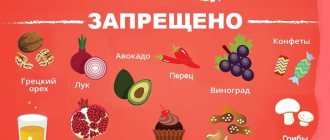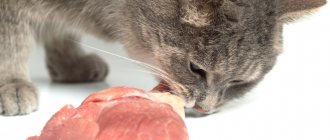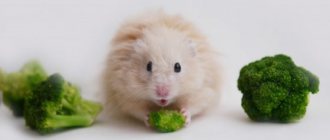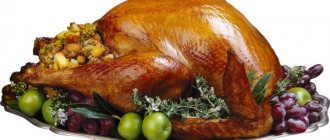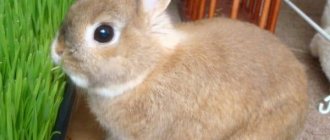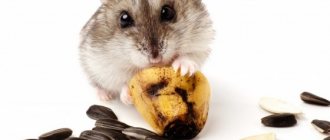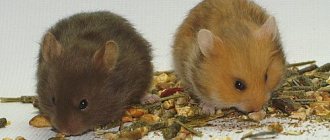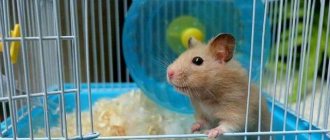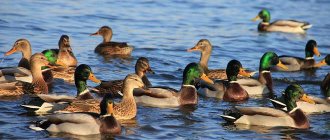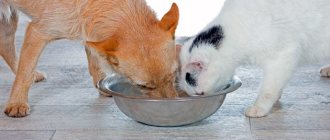A diet based on cereals has become the basic diet for many rabbit breeders. The economic availability of feed and ease of use have made this method quite popular. With all the variety of cereals, not every crop is beneficial for rabbits. What grain to feed rabbits, and which type most fully meets all the necessary nutritional characteristics, read on.
What grain to feed rabbits
Features of the digestive system of eared animals
Before creating a diet for rabbits, you should study their digestive system.
With the help of incisors, they eat coarse food, and the molars are involved in crushing it. Then, under the influence of saliva, the food becomes soft and is sent down the esophagus to the stomach, where it is broken down by various enzymes. The stomach of furry pets is single-lined. Its walls are quite thin and equipped with flaccid muscles, so they are not equipped with gag reflexes and are not able to vomit.
The structure of the rabbit's digestive system
After 1 to 7 hours, the food reaches the duodenum, which is 12 cm long. The intestines are also poorly developed: this suggests that the further movement of food depends entirely on fresh food that has just entered the stomach. It is this that promotes pushing, and not peristalsis, as is the case with the human body.
Rabbits should never be short of food.
Grain feed for rabbits: rules of preparation and consumption
The grain is perfectly compatible with the digestive system of furry pets, and is digested much better than bone meal, for example. In winter, feeding animals with cereals is a vital necessity, since a hay-vegetable diet does not contribute to rapid weight gain.
The ranking of the best cereal crops is headed by:
- barley;
- wheat;
- oats
The high nutritional value of grain has made it a popular product in the diet of furry pets.
Besides the fact that rabbits always eat with great appetite, purchasing them is not difficult at all, and they are in an affordable price range. Along with the listed crops, the rabbits are fed corn.
Rabbit breeders recommend mixing different crops. This is due to their different spectrum of effects on the rabbits’ body. For example, oats are digested faster than barley, and when fed exclusively barley, rabbits accumulate excess internal fat.
Wheat is given only in small doses; in large quantities it provokes bloating
Why doesn't the rabbit eat oats?
If prepared correctly before feeding, it is well eaten by rabbits. Let us highlight two reasons (false and real).
- If you feed whole grains, the rabbit will shell the grains on its own. It seems that the rabbits do not eat, in fact the grain is eaten, only the husk remains. In short, if the rabbit does not look hungry, close this question.
- Do not eat moldy grain. It is not the mold that is dangerous, but its toxins. Toxins impart an unpleasant bitter taste to the grain. They cannot be destroyed by boiling. Sometimes the grain appears normal.
Adding feed sorbents reduces the risk of feed, but does not improve the taste. The most well-known mycotoxins are zearalenone, aflatoxin and their derivatives. Mycotoxins cause food refusal, in small quantities - infertility in rabbits, reduce the level of immunity, and sometimes cause death.
Mycotoxins are the main danger of grain feed, the cause of subclinical toxicosis in rabbits
It is difficult to exclude damage to oats by toxins, because they are metabolic products of microscopic fungi. The simplest diagnostic method is organoleptic. The taste and smell are bitter. Usually moist, rotten grain is affected by mycotoxins.
The benefits of grain crops for animals
Grain is a vital and important component of the nutrition system of furry pets. The set of valuable components varies depending on its variety.
| View | Beneficial features |
| Oats | Pantothenic acid, which is part of it, helps maintain the animals' organisms in good shape, and also improves reproductive function. Despite the fact that it is quite high in calories, it does not lead to obesity. Its share in the total feed mass can be about 50%. |
| Barley | This cereal is more nutritious than oats. The energy value of barley is higher than its counterpart by as much as 20%! It is incredibly beneficial for the digestive system of animals, and it is also recommended to feed it to nursing rabbits and young rabbits for rapid weight gain. Contains amino acids important for the animal body. The negative aspects of its use include the film-like coating, which is quite difficult to digest. It is recommended to thoroughly grind the grains before use. |
| Wheat | It boasts a large amount of B vitamins. Feed wheat should be used as feed. The recommended proportion in mixtures is 25%. It is not recommended to feed animals only this type of cereal, because... Long-term use is fraught with bloating and impaired mineral metabolism. |
| Corn | It contains large quantities of carotene, carbohydrates and vitamin E. Rabbits should not be given exclusively corn, because It is low in protein and calcium, and long-term consumption leads to obesity. Due to its high fat content, it goes rancid quickly. You can crush it together with the rods. It is best to feed corn in mixtures. |
In the case of using a grain-based nutrition system, it should not be forgotten that water must be constantly available. It is recommended to change it 2 times a day: in the morning and before bed.
Feed mixtures
The grain mixture is especially necessary in winter. After all, if you give each cereal seed separately, there will be an excess of some vitamins and a lack of others. Only from mixtures can a rabbit receive the norm of all vitamin groups and feel good. The preparation of a balanced feed may vary. You can familiarize yourself with the norms for the amount of each grain in the mixture in percentage terms by studying the table.
| Cereals | Barley % | Wheat % | Corn % | Oats % | Bran % |
| Young animals during the growth period | 15 | 10 | 30 | 30 | 15 |
| For adult rabbits | 20 | 20 | 10 | 40 | 10 |
| For meat breeds | 40 | 20 | 15 | 15 | 10 |
Feeding rules
In order to properly feed long-eared animals with grain, it is necessary to serve it correctly and to understand how much it is needed. Many rabbit breeders recommend feeding their pets dry cereals. But experts with many years of experience believe that this method is not correct: barley, for example, should be crushed using a grain crusher due to its solid structure.
The easiest method of feeding grain is to grind it and steam it with hot water.
Wheat and oats are fairly soft crops, so they are recommended to be given in their pure form, without prior crushing and infusion in water. Rabbits chew them quite quickly.
In order to understand how to feed grain crops, you should understand the age categories of rabbits. The younger generation is given a mixture half made of wheat. The remaining amount is formed from equal shares of barley and corn. Females caring for their offspring are offered oats and barley in equal proportions, since these cereals have high energy value. For breeding males, a mixture of ¼ wheat and ¾ oats is made.
Breeding males are given food consisting of ¼ oats and ¾ wheat
Prices for grain grinder
Chopper for crushing all types of feed grains and seeds
Feeding rabbits using the Zolotukhin method
The essence of this method is to feed animals with dry or soaked grain.
Females who are not busy reproducing offspring are fed whole dry oats. Immediately before mating and giving birth, they are offered crushed barley. Rabbits who have switched to self-feeding are given steamed oats. In the warm season, oats are combined with barley. Crushed corn can only be given when babies reach 4 months. Sexually mature males are fed dry oat-barley mixtures with the addition of corn.
Drawing of Zolotukhin cells
Yeasting
The method of preparing grain for rabbits is used for active growth and weight gain. The practice of feeding yeast feed gives high performance in meat breeds; this type of feeding is allowed from 4 months. Warm water is poured into a container with ground grain in a ratio of 1:2, 36 g of yeast are diluted into 2 liters of water. The composition is mixed and left overnight. Fermentation will take 6 or 9 hours, during which time the mass is stirred periodically. In the morning, pets are fed by adding 2-3 tablespoons to a portion of dry cereal with each meal. This continues for about five days, then the food is changed.
The ABCs of Eared Eating
To ensure that these cute creatures with such a weak gastrointestinal tract never experience a lack of quality food, you should familiarize yourself with the basics of feeding them. Good nutrition energizes them, supplies them with useful elements and helps maintain the desired body temperature. Plant-based foods are the starting point from which to start when choosing food for pets. Food of animal origin must be introduced into the food system of eared animals in smaller quantities, mainly in the form of vitamins and other minerals.
Plant foods, so beneficial for eared animals, are found everywhere. Some baits are included in the menu as an obligatory component, like vegetables or hay, while others, like fruits, for example, are given as dessert.
Rabbits have a varied diet, but everyone knows how much they love carrots.
What is better to feed rabbits - grain or mixed feed?
Concentrated feeds are also beneficial for rabbits, especially at times when it is not possible to provide them with fresh herbs or greens. Concentrated, or roughage, feeds include compound feed, oilseeds (usually bran and cakes) and legumes.
In addition to the usual greens and grains, rabbits also happily absorb waste from vegetable growing, for example, carrot and potato skins or cabbage leaves: they can also be included in the diet in small quantities, alternating with other foods. It is usually recommended to introduce combinations of grains, in all their types, and alternately introduce fresh greens, vegetable tops, mixed feed, cakes, etc. into the diet.
Most often, compound feeds use a ready-made combination of all the necessary elements, so they are perfect for those who do not have the opportunity to independently purchase different types of grains or mix them together. Such food is sold in special stores and even in markets.
Types of feed
There are 4 main types of feed:
- green;
- concentrated;
- juicy;
- rude.
There is a variety of food for rabbits
Green feed
With the arrival of spring, the problem of finding food is solved by itself: the first branches released can already serve as food for pets.
You can stick to this type of feeding until the end of autumn.
Green food is the basis of the menu in the warm season
This type of food implies:
- wild herbs;
- vegetable tops.
Green grass, so beloved by long-eared animals, should be harvested in the place where it grows. If there is an area suitable for cultivating herbs in nearby areas, you should plant them there. It is this type of feed that is so rich in fiber. In addition, it perfectly satisfies the feeling of hunger.
The diet of rabbits must include hay or tree branches
Roughage
Branches of woody plants, hay and grass meal are the main components of this type of nutrition. In winter, twig food serves as an excellent help, helping to enrich the feeding regimen of long-eared animals. The positive aspect of feeding on branches is that animals stop gnawing equipment, focusing exclusively on tasty tree shoots.
Pre-prepared branch food is an excellent supplement in cold weather.
Find out more about the features of feeding rabbits with branches in our article: What branches can be given to rabbits?
Let's look at the benefits of twig food for a rabbit's health. How to collect, dry, prepare branches and how to feed them to furry animals?
Juicy feed
Relevant in winter, when root crops and silage become sources of all the necessary elements. The diversity of the diet with this feeding system depends on the region where rabbits live: in places where melons grow, long-eared rabbits are fed zucchini and pumpkins, for example.
Also during this period, pre-harvested silage is used.
Juicy feed provokes an increase in milk supply
Concentrated feed
Especially relevant in the cold season. This category means:
- cereals;
- animal feed;
- compound feed;
- bran.
Concentrated feeds are the most nutritious
Due to their high nutritional value, grain feeds make up the bulk of the rabbits' diet. This is especially true in the winter. They can be added to feed up to 75% of the total weight of the mixture. Oats are considered the best option for feeding eared animals: both adults and young animals eat it with great pleasure.
The most important rule of any nutrition plan: balance and variety.
How to prepare a grain mixture
Grain mixture for rabbits is the best option for a balanced diet that will provide animals with a full range of nutrients, vitamins, and minerals.
| Examples of grain mixtures | ||
| Period of active growth of young animals (example 1) Corn - 30%; Oats - 30%; Wheat - 10%; Barley – 15%; Cereal bran – 15%. | Grain ratio for adult breeding rabbits (example 2) Oats – 40%; Wheat – 20%; Barley – 20%; Corn – 10%; Bran – 10%. | When fattening for meat (example 3) Barley - 40%; Wheat – 20%; Corn – 15%; Oats – 15%; Cereal bran - 10%. |
| Composition of the grain mixture for adult non-breeding livestock (example 4) Oats – 50%; Corn – 20%; Wheat – 20%; Barley – 10%. | When fattening for meat (example 5) Barley 35%; Corn 25%; Sunflower cake 10%; Oats 15%; Wheat 15%. | When fattening for meat (example 6) Barley – 35%; Wheat – 35%; Oats – 10%; Corn – 10%; Sunflower seeds – 10%. |
Recommendations:
- Increase the nutritional value of the young stock mixture by reducing the “fresh” varieties.
- For sexually mature female rabbits, limit the dose of wheat grain, replacing it with a less calorie one.
- If you gain weight, remove barley from your diet.
- If any grain causes bloating, exclude it from the menu.
Unripe grain in soft green ears can be fed whole to animals. But dried out spikelets can destroy the eared one. Therefore, mature grain is given only threshed.
All recommendations can be changed, adapting to the individual needs of animals, taking into account the season, physiological state, and breed characteristics.
Video Making grain mixture for rabbits
Feed mixture for winter
In summer and spring, the main food for rabbits is green food, which meets the needs of the ears. But in autumn and winter it is quite difficult to provide a complete diet. Grain mixtures come to the aid of rabbit breeders. They not only meet the needs of rabbits, but also provide the energy costs that animals experience when the temperature drops.
In the winter diet, the mandatory components should be: grain (mixed feed) - 65%, hay - 20%, root vegetables - 15%.
